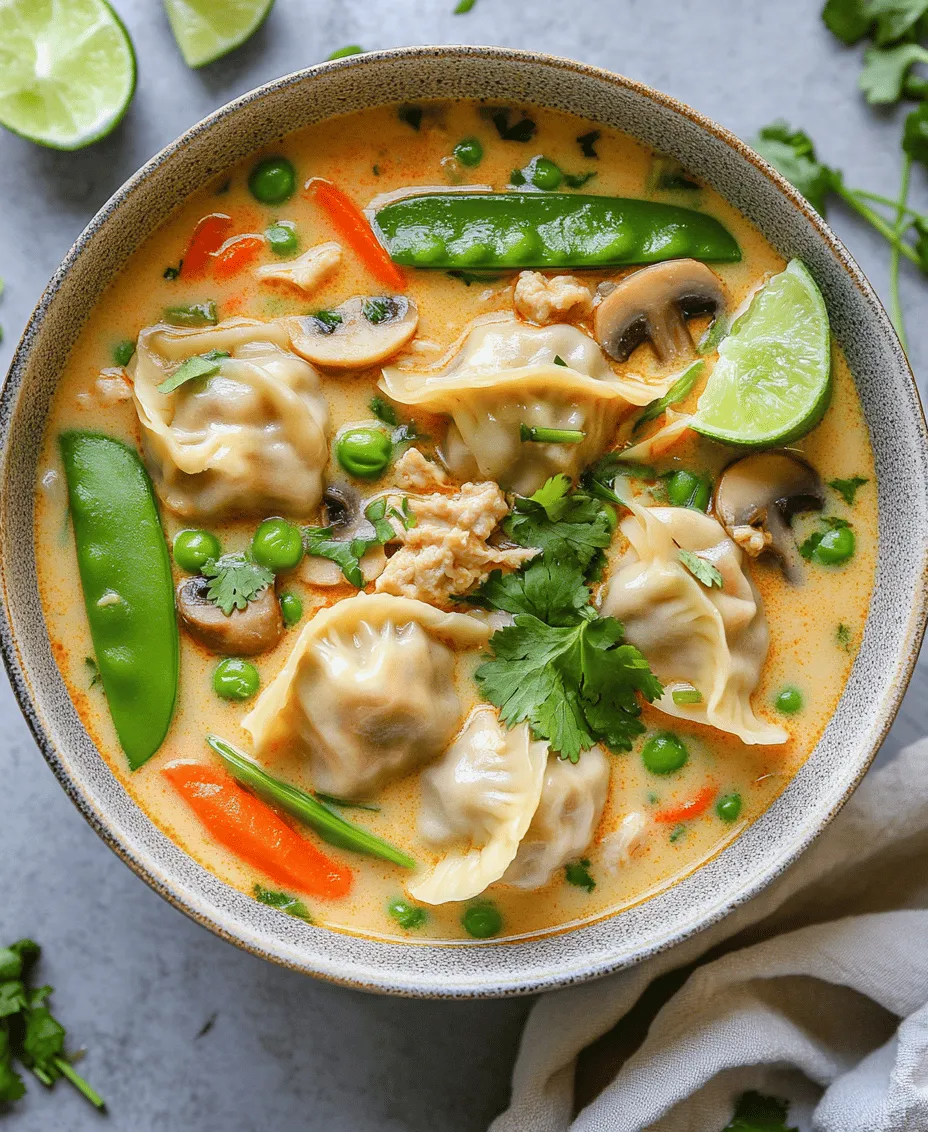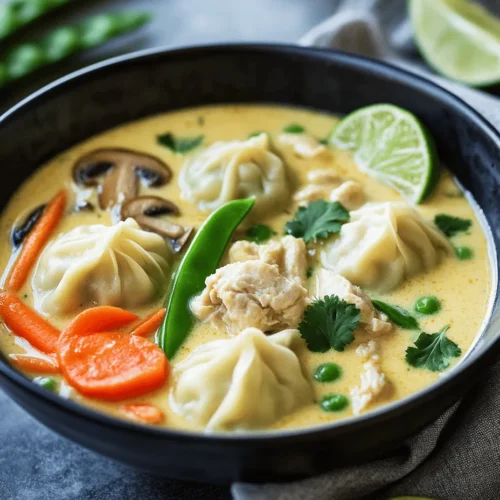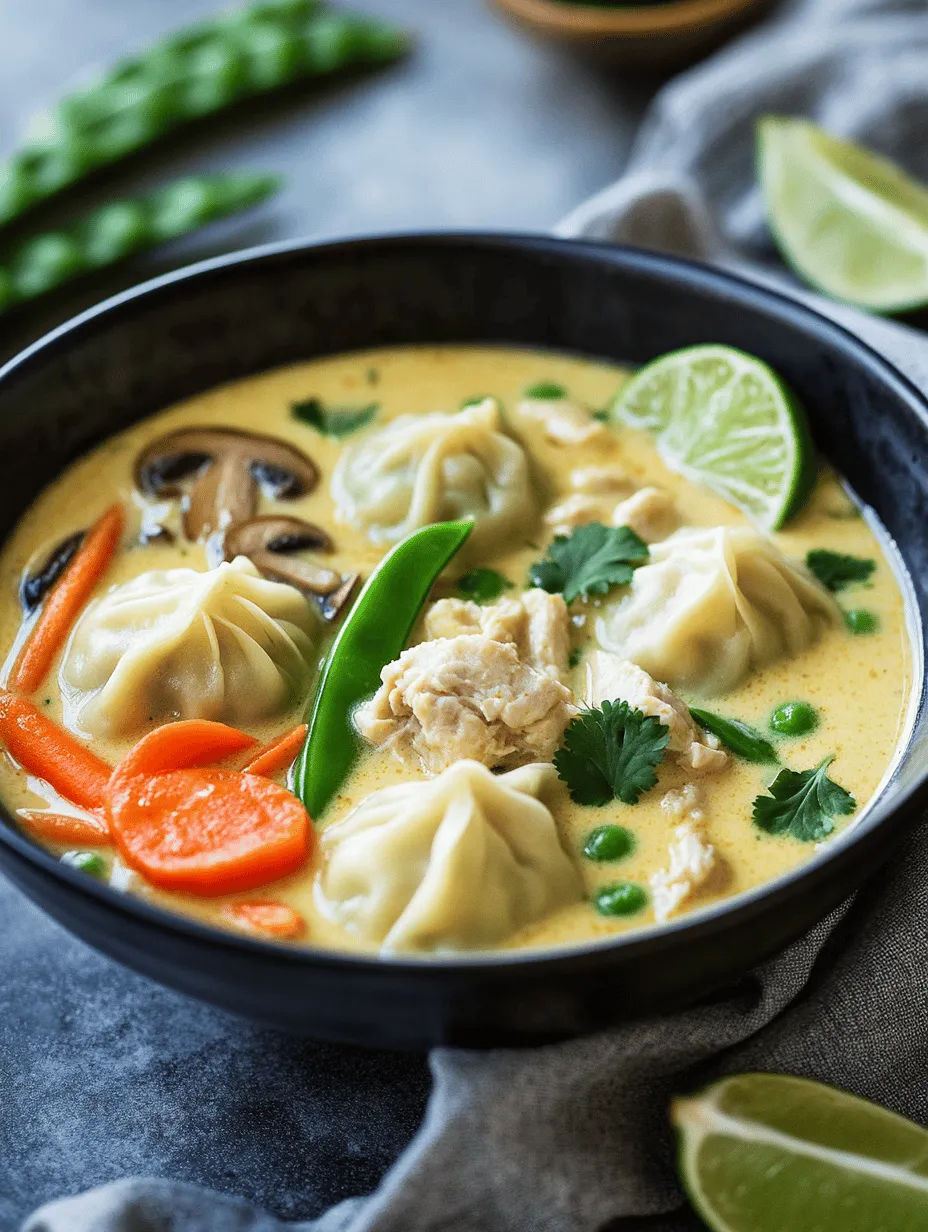Introduction
Curry dumpling soup is a dish that beautifully marries the rich, comforting essence of traditional soup with the delightful, textural intrigue of dumplings. With roots in various Asian cuisines, this dish has garnered popularity across cultures, celebrated not only for its vibrant flavors but also for its ability to bring people together. Its comforting warmth makes it a perennial favorite, especially during colder months or when one craves a hearty meal that nourishes both body and soul.
The fusion of flavors in curry dumpling soup is a result of the seamless blend of spices, herbs, and creamy textures. The aromatic notes of curry powder combined with the freshness of ginger and garlic create a symphony of tastes that dance on the palate. The dumplings, whether filled with ground chicken or tofu, serve as delightful pockets of flavor, enhancing the overall experience of the soup.
For comfort food lovers, nothing beats the satisfaction of homemade dishes. Making your own dumplings and soup allows for customization in flavors, fillings, and spice levels, ensuring that every bowl is tailored to your liking. Whether you’re cooking for family or entertaining friends, this curry dumpling soup is sure to impress and warm the heart.
Understanding the Ingredients
To truly appreciate the art of crafting curry dumpling soup, it’s essential to understand the role of each ingredient in creating this symphonic dish. The interplay of flavors and textures hinges on the careful selection of components, each contributing to the overall appeal of the dish.
Key Ingredients and Their Culinary Roles
1. All-Purpose Flour: The foundation of the dumpling dough, all-purpose flour is crucial for creating the right texture. The gluten in the flour provides elasticity, allowing the dough to be rolled out thinly and shaped without tearing. It’s important to use high-quality flour for the best results, as it directly impacts the dumpling’s chewiness.
2. Ground Chicken or Tofu: The filling is where creativity can shine. For those who prefer meat, ground chicken offers a juicy, flavorful base that pairs well with the spices used in the soup. Alternatively, tofu serves as an excellent vegetarian option, absorbing the surrounding flavors while providing a satisfying bite.
3. Spices: The heart of the flavor profile in curry dumpling soup lies in the spices. Curry powder, often a blend of turmeric, cumin, coriander, and other spices, provides warmth and depth. Fresh ginger adds a zesty brightness, while garlic infuses the dish with a savory undertone. Balancing these spices is key to achieving a harmonious flavor.
4. Broth and Coconut Milk: The soup base is where the magic happens. A rich broth, whether homemade or store-bought, serves as the canvas for the dish. Adding coconut milk introduces a creamy richness that complements the spices beautifully, creating a luxurious mouthfeel. The combination of broth and coconut milk forms the heart of the soup, enveloping the dumplings in a warm embrace.
5. Vegetarian Options and Variations: The beauty of curry dumpling soup lies in its versatility. There are numerous ways to adapt the recipe to suit dietary preferences. For a vegetarian version, the filling can be made with a mixture of finely chopped vegetables, mushrooms, and tofu, seasoned with the same aromatic spices. Additionally, gluten-free alternatives can be explored, such as using rice flour for the dumpling wrappers.
The Dumpling Process: Crafting Homemade Dumplings
Now that we’ve established the essential ingredients, it’s time to dive into the process of making homemade dumplings. Crafting your own dumplings from scratch can seem daunting, but with a clear step-by-step guide, you’ll find it to be an enjoyable and rewarding experience.
Step-by-Step Guide to Making Dumpling Dough
1. Mixing the Dough: Begin by combining all-purpose flour and a pinch of salt in a large mixing bowl. Gradually add boiling water to the flour mixture while stirring with chopsticks or a fork. The heat from the water helps to hydrate the flour, resulting in a pliable dough.
2. Kneading for Texture: Once the dough begins to come together, transfer it to a lightly floured surface. Knead the dough for about 5-7 minutes until it becomes smooth and elastic. This step is crucial, as it develops the gluten structure that gives the dumplings their chewy texture.
3. Resting the Dough: After kneading, wrap the dough in plastic wrap or cover it with a damp cloth. Allow it to rest for at least 30 minutes. This resting period relaxes the gluten, making it easier to roll out the dough and shape the dumplings.
Preparing the Filling for Dumplings
While the dough is resting, you can prepare the filling for the dumplings. The filling not only provides flavor but also contributes to the overall texture of the soup.
1. Balancing Flavors: In a mixing bowl, combine your choice of ground chicken or crumbled tofu with finely chopped vegetables, such as scallions, carrots, or spinach. Season the mixture with salt, pepper, and the aromatic spices mentioned earlier—curry powder, ginger, and garlic. Feel free to add fresh herbs like cilantro or parsley for an added layer of freshness.
2. Experimenting with Fillings: One of the joys of making dumplings lies in the ability to experiment. You can create a variety of fillings based on personal preferences. For instance, consider adding diced mushrooms for an umami kick or using a blend of different proteins for a more complex flavor profile.
3. Testing for Flavor: Before assembling the dumplings, it’s wise to cook a small spoonful of the filling in a pan to taste it. This will allow you to adjust seasoning as needed, ensuring that every bite is flavorful.
Shaping and Cooking the Dumplings
With the dough and filling ready, it’s time to shape the dumplings. This step allows you to showcase your culinary skills and creativity.
Techniques for Forming Perfect Dumplings
1. Rolling the Dough: On a lightly floured surface, roll out the rested dough to a thickness of about 1/8 inch. Use a round cutter or a glass to cut out circles from the dough. Aim for uniform sizes to ensure even cooking.
2. Filling the Dumplings: Place a small spoonful of filling (about a teaspoon) in the center of each dough circle. Be careful not to overfill, as this can cause the dumplings to burst during cooking.
3. Sealing Techniques: To seal the dumplings, fold the dough over the filling to create a half-moon shape. Press the edges together firmly to ensure they are sealed well. You can also crimp the edges with your fingers or a fork for added security and a decorative touch.
Cooking Methods for Dumplings
Dumplings can be cooked in various ways, each offering a unique texture and flavor profile.
1. Boiling: The most traditional method involves boiling the dumplings in a pot of salted water. Bring the water to a rolling boil, then carefully drop in the dumplings. Cook them until they float to the surface, which usually takes about 3-5 minutes.
2. Steaming: For a lighter option, you can steam the dumplings. Arrange them in a steamer basket lined with parchment paper to prevent sticking. Steam over simmering water for about 10-15 minutes until cooked through.
3. Pan-Frying: For a crispy texture, consider pan-frying the dumplings. Heat a little oil in a non-stick skillet, add the dumplings, and fry until the bottoms are golden brown. Then, add a splash of water and cover the skillet to steam the dumplings until cooked through. This method provides a delightful contrast between crispy and tender textures.
By mastering these initial steps and understanding the ingredients, you will be well on your way to creating the best curry dumpling soup that is sure to impress family and friends alike. Enjoy the journey of crafting this beloved dish, and prepare to savor the delightful flavors that await you!

Steaming vs. Pan-Frying: Pros and Cons
When it comes to preparing dumplings for your Curry Dumpling Soup, you have two primary cooking methods to choose from: steaming and pan-frying. Each method has its own distinct advantages and drawbacks that can influence the final outcome of your dish.
Steaming dumplings is a method that ensures they remain moist and tender. The gentle heat of the steam allows the dumplings to cook evenly, preventing the outer wrapper from becoming tough or overly crisp. This method is excellent for maintaining the delicate texture of the dumpling fillings, whether you choose chicken, tofu, or vegetables. However, steaming may not impart the same depth of flavor as pan-frying, which can add a delightful crispy texture and a hint of caramelization to the dumpling’s exterior.
On the other hand, pan-frying offers a beautiful golden-brown crust, enhancing the dumpling’s flavor profile. The Maillard reaction that occurs during frying creates a savory depth, which can beautifully complement the rich flavors of your curry soup. However, pan-frying can lead to a slightly drier dumpling if not monitored carefully, as the high heat may cause the moisture inside to evaporate.
Ultimately, the choice between steaming and pan-frying comes down to personal preference. If you prefer a softer, more tender texture, steaming is the way to go. If you enjoy a contrast of textures with a crispy bite, opt for pan-frying. Whichever method you choose, be sure that it aligns with the overall flavor and texture profile you envision for your Curry Dumpling Soup.
Creating the Flavorful Soup Base
The heart of your Curry Dumpling Soup lies in its flavorful broth. A well-prepared soup base not only serves as a vehicle for your dumplings but also elevates the entire dish with depth and complexity. Here’s how to create a delicious soup base that will tantalize your taste buds.
Steps for Preparing the Soup
1. Start with Aromatics: Begin by heating a tablespoon of oil in a large pot over medium heat. Add chopped onions, minced garlic, and grated ginger. Sauté until the onions are translucent and fragrant, about 4-5 minutes.
2. Add the Curry Paste: Next, incorporate a generous tablespoon of red curry paste into the pot. Stir it in with the aromatics, allowing it to cook for an additional minute, which will help release its essential oils and flavors.
3. Simmer with Broth: Pour in your choice of chicken or vegetable broth, bringing the mixture to a gentle boil. The simmering process is crucial; it allows the flavors to meld together, enhancing the overall taste of the soup.
4. Add Coconut Milk: Once the broth is bubbling, reduce the heat to low and stir in a can of coconut milk. This ingredient adds a rich creaminess to the soup, balancing the heat from the curry paste with a subtle sweetness.
5. Season the Broth: To achieve a well-rounded flavor, add a splash of fish sauce and a squeeze of fresh lime juice. These ingredients will introduce umami and acidity, elevating the soup to new heights.
6. Incorporate Vegetables: Finally, add your choice of vegetables such as sliced mushrooms, diced carrots, and snap peas. These not only provide nutritional benefits but also add various textures and colors to the soup. Simmer the mixture for an additional 10-15 minutes, allowing the vegetables to soften while maintaining a bit of crunch.
Importance of Simmering the Broth for Depth of Flavor
Simmering your broth is essential for developing a rich, layered flavor profile. The low and slow cooking method allows the ingredients to release their flavors gradually, creating a harmonious blend that packs a punch in every spoonful. Take your time during this step; the longer you let it simmer, the more flavorful your soup will become.
Balancing Flavors with Fish Sauce and Lime Juice
Fish sauce is a staple in many Southeast Asian cuisines, adding an umami kick that deepens the flavor of your broth. Use it sparingly and adjust to your taste. The acidity from lime juice balances the richness of the coconut milk, creating a well-rounded soup that is not overly heavy. Always taste as you go, making adjustments to ensure the perfect balance.
Discussing the Addition of Vegetables for Nutrition and Texture
Incorporating fresh vegetables into your Curry Dumpling Soup not only enhances its nutritional value but also contributes to the overall texture and visual appeal of the dish. Vegetables like mushrooms provide a savory, earthy flavor, while carrots add a subtle sweetness. Snap peas contribute a delightful crunch, making each bite exciting.
Fresh vegetables are not only healthier but also more vibrant, offering a brighter flavor profile compared to their frozen counterparts. When selecting your vegetables, aim for a mix of colors and textures to create a visually appealing and nutritious soup.
Combining the Elements: Bringing It All Together
Now that you have a flavorful soup base and perfectly cooked dumplings, it’s time to bring these elements together to create your Curry Dumpling Soup.
Merging Dumplings with the Soup
Once your broth is ready, carefully add the pre-cooked dumplings into the simmering soup. This step is essential because it allows the dumplings to absorb the flavors of the broth without compromising their texture.
Tips for Gently Folding Dumplings into the Soup
When adding the dumplings, use a slotted spoon or a spider strainer to gently lower them into the pot. This technique prevents splashing and ensures that the dumplings are evenly distributed throughout the soup. Avoid stirring too vigorously, as this can break apart the delicate dumplings. Instead, lightly swirl the soup to incorporate the dumplings gradually.
Ensuring Even Heating Without Breaking Dumplings
Maintain the heat at a low simmer to ensure that the dumplings warm through without overcooking. You want them heated just enough to meld with the flavors of the soup, while still retaining their shape. This gentle heating will allow the dumplings to absorb some of the broth’s flavor, enhancing the overall dining experience.
Final Touches: Garnishing and Serving Suggestions
Presentation is key when serving your Curry Dumpling Soup. Ladle the soup into bowls, ensuring each serving has a good amount of dumplings and vegetables. To elevate the dish, garnish with fresh herbs like cilantro or basil, and add a sprinkle of sliced green onions for an added pop of color and freshness. A wedge of lime on the side allows diners to add an extra squeeze of acidity to their soup if desired.
Ideas for Plating and Enhancing Presentation
To enhance the visual appeal of your soup, consider using shallow bowls that allow the vibrant colors of the curry and vegetables to shine. You can also serve the soup with a side of jasmine rice or crusty bread, providing a wonderful contrast to the soup’s flavors and textures.
Recommendations for Side Dishes or Pairings
Pair your Curry Dumpling Soup with light and refreshing side dishes, such as a simple cucumber salad or steamed greens. The crispness of these sides complements the warmth of the soup, creating a balanced meal. Additionally, a light, fruity beverage like a mango lassi or iced green tea can enhance the dining experience, providing a refreshing contrast to the rich, spicy flavors of the soup.
Nutritional Benefits of Curry Dumpling Soup
Curry Dumpling Soup is not only a delightful dish but also a nutritious one, packed with health benefits from its key ingredients.
Overview of the Health Benefits of Key Ingredients
The primary ingredients in your curry soup contribute significantly to its nutritional profile. Chicken or tofu provides a good source of protein, essential for muscle repair and growth. Fresh vegetables like carrots, mushrooms, and snap peas are rich in vitamins, minerals, and dietary fiber, promoting overall health.
Nutritional Value of Chicken/Tofu and Vegetables
Chicken is an excellent source of lean protein, which can support weight management and muscle health. Tofu, on the other hand, is a plant-based protein that is low in calories and high in essential amino acids, making it suitable for vegan and vegetarian diets. The vegetables added to the soup not only enhance flavor but also deliver crucial nutrients such as vitamin A, vitamin C, and potassium.
Benefits of Spices Like Turmeric and Ginger
Spices play a vital role in the nutritional benefits of Curry Dumpling Soup. Turmeric, the main spice in curry powder, contains curcumin, which has anti-inflammatory and antioxidant properties. Ginger is known for its digestive benefits and has been used for centuries to alleviate nausea and reduce inflammation. Incorporating these spices not only enhances flavor but also contributes to a healthier meal.
Discussing the Balance of Flavors and Nutrition in a Comforting Meal
Curry Dumpling Soup is a perfect example of how flavors and nutrition can coexist harmoniously. The balance of spices, protein, and fresh vegetables creates a comforting dish that satisfies both the palate and the body. This soup is not just a meal; it’s a nurturing experience that provides warmth and comfort, making it ideal for sharing with loved ones.
Conclusion
Curry Dumpling Soup is not only a delightful and comforting dish, but it also offers an enjoyable cooking experience that invites creativity and exploration in the kitchen. With its rich, flavorful broth, tender dumplings, and vibrant vegetables, this recipe will become a favorite in your household.
I encourage you to try making this recipe at home, experimenting with your choice of proteins and vegetables to make it your own. The joy of cooking and sharing homemade meals with family and friends is unparalleled. As you gather around the table, savor each bite of this nourishing soup, and relish in the connections that come from sharing food. Enjoy the process and celebrate the warmth of homemade cooking with every bowl of Curry Dumpling Soup you create.



